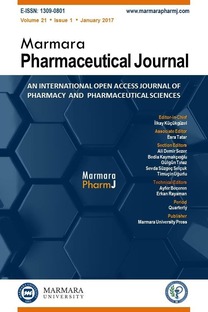Comparatively investigation of grape molasses produced by conventional and industrial techniques
___
[1] Xia EQ, Deng GF, Guo YJ, Li HB. Biological activities of polyphenols from grapes. Int J Mol Sci. 2010; 11:622-646.[2] Yang Y, Xiao YY. Grape phytochemicals and associated health benefits. Crit Rev Food Sci Nutr. 2013; 53:1202–1225.
[3] Nassiri-Asl M, Hosseinzadeh H. Review of the pharmacological effects of Vitis vinifera (Grape) and its bioactive constituents. An Update Phytother Res. 2016; 30:1392-1403.
[4] Özcan M, Alpar Ş, Juhami-Al F. The effect of boiling on qualitative properties of grape juice produced by the traditional method. J Food Sci Technol. 2015; 52:5546-5556.
[5] Atabey E. Pekmez ve Pekmez Toprağı. Popüler Bilim Derg. 2011; 19:38-43.
[6] Rice-Evans C, Miller NJ, Paganga G.Antioxidant properties of phenolic. Trends Plant Sci. 1997; 2:152-159.
[7] Keser S, Celik S, Turkoglu S. Total phenolic contents and freeradical scavenging activities of grape (Vitis vinifera L.) and grape products. Int J Food Sci Nutr. 2013; 64:210-216.
[8] Celep E, Charehsaz M, Akyüz S, Türköz-Acar E, Yesilada E. Effect ofin vitro gastrointestinal digestion on the bioavailability of phenolic components and the antioxidant potentials of some Turkish fruit wines. Food Res Int. 2015; 78:209–215.
[9] Chen YT, Lin KW. Effects of heating temperature on the total phenolic compound, antioxidative ability and the stability of dioscorin of various yam cultivars. Food Chem. 2007; 101:955–963.
[10] Gawlik-Dziki U. Effect of hydrothermal treatment on the antioxidant properties of broccoli (Brassica oleracea var. botrytis italica) florets. Food Chem. 2008; 109:393-401.
[11] Podsedek A, Sosnowska D, Redzynia M, Koziotkiewicz M. Effect of domestic cooking on the red cabbage hydrophilic antioxidants. Int J Food Sci Technol. 2008; 43:1770-1777.
[12] Wolosiak R, Worobiej E, Piecyk M, Druzynska B, Nowak D, Lewicki PP. Activities of amine and phenolic antioxidants and their changes in broad beans (Vicia faba) after freezing and steam cooking. Int J Food Sci Technol. 2009; 45:29-37.
[13] Ross CF, Hoye C, Fernandez-plotka VC. Influence of heating on the polyphenolic content and antioxidant activity of grape seed flour. J Food Sci. 2011; 76:884-890.
[14] Pinelo M, Rubilar M, Sinerio J, Nunez MJ. A thermal treatment to increase the antioxidant capacity of natural phenols: Catechin, resveratrol and grape extract cases. Eur Food Res Technol. 2005; 221:284-290.
[15] Kim SY, Jeong SM, Park WP, Nam KC, Ahna DU, Lee SC. Effect of heating conditions of grape seeds on the antioxidant activity of grape seed extract. Food Chem. 2006;97:472-479.
[16] Calligaris S, Manzocco L, Anese M, Nicoli MC. Effect of heattreatment on the antioxidant and pro-oxidant activity of milk. Int Dairy J. 2004;14:421-427.
[17] Jiu J, Goyer RA, Waalkes MP. Toxic effects of metals. In: The Casarett & Doull’s Toxicology the basic science of poisons, (ed. C. D. Klaassen). Mc Graw Hill., New York,2008, pp. 931-979.
[18] Türk Gıda Kodeksi Üzüm Pekmezi Tebliği, TEBLİĞ NO: 2007/27, 2007, http://www.resmigazete.gov.tr/ eskiler/2007/06/20070615-6.htm (accessed December 20, 2016).
[19] American recommendations, Food and Nutrition Board, Institute of Medicine, National AcademicPress,2011,https:// www.nal.usda.gov/sites/default/files/fnic_uploads// recommended_intakes_individuals.pdf. (accessed December 20, 2016).
[20] Singleton VL, Orthofer R, Lamuela-Raventos RM. Analysis of total phenols and other oxidation substrates and antioxidants by means of Folin-Ciocalteu reagent. Methods Enzymol. 1999; 299:152-178.
[21] Samatha T, Shyamsundarachary R, Srinivas P, Swamy NM. Quantification of total phenolic and total flavonoid contents in extracts of Oroxylum indicum L. Kurz. Asian J Pharm Clin Res. 2012; 5:177–179.
[22] Prieto P, Pineda M, Aguilar M. Spectrophotometric quantitation of antioxidant capacity through the formation of a phosphomolybdenum complex: Specific application to the determination of vitamin E. Anal Biochem. 1999; 269: 337– 341.
[23] Apak R, Güçlü K, Özyürek M, Karademir SE. Novel total antioxidant capacity index for dietary polyphenols and vitamins C and E, using their cupric ion reducing capability in the presence of neocuproine: CUPRAC method. J Agric Food Chem. 2004; 52:7970–7981.
[24] Jayaprakasha GK, Jaganmohan RL, Sakariah KK. Antioxidant activities of flavidin in different in vitro model systems. Bioorg Med Chem. 2004; 12(19):5141-5146.
[25] Altundag H, Bina E, Altıntıg E. The levels of trace elements in honey and molasses samples that were determined by ICPOES after microwave digestion method. Biol Trace Elem Res. 2016; 170: 508–514.
- ISSN: 1309-0801
- Yayın Aralığı: Yılda 6 Sayı
- Başlangıç: 1985
- Yayıncı: Marmara Üniversitesi
Türkiye’de mide ülserinde kullanılan tıbbi bitkiler
Şükran KÜLTÜR, Onur ALTINBAŞAK, Sezin ANIL, Gülay MELİKOĞLU
Comparative phytochemical evaluation of natural and micropropagated plants of Bacopa monnieri (L.)
Firoj A. TAMBOLI, Vinod D. RANGARI, Suresh G. KILLEDAR, Sagar U. JADHAV, Trupti S. GHATAGE, Vishwajeet P. KORE
GÜLSEN TEL ÇAYAN, Ebru DEVECİ, Fatih ÇAYAN, Emin Mehmet DURU
Cocos nucifera L. endosperm promotes healing of excised wound in BALB/c mice
Erna C. AROLLADO, Leslie B. TOMAGAN, Kerstin Mariae G. PONSARAN, Richelle Ann M. MANALO, Gerwin Louis T. DELA TORRE, Arlene A. SAMANIEGO, Rohani B. CENA, Josephine D. AGAPITO
Comparatively investigation of grape molasses produced by conventional and industrial techniques
Sinem HELVACIOĞLU, Mohammad CHAREHSAZ, Etil GÜZELMERİÇ, Ebru TÜRKÖZ ACAR, Erdem YEŞİLADA, Ahmet Hamdi AYDIN
Mastura IBRAHIM, Saripah Salbiah SYED ABDUL AZZIZ, Chee Fah WONG, Wan Nor Izzati WAN MOHAMAD DIN, Wan Rusmawati WAN MAHAMOD, Yuhanis MHD BAKRI, Mohamad Syahrizal AHMAD, Rozita YAHAYA, Nor Hadiani ISMAIL, Wan Mohd Nuzul Hakimi Wan SALLEH
In vitro antioxidant and cytotoxic activity of Muscari neglectum growing in Turkey
Esra EROĞLU ÖZKAN, Serpil Demirci KAYIRAN, Turgut TAŞKIN, Mahmoud ABUDAYYAK
Antioxidant and anti-inflammatory activities of Phlomis pungens and Coridothymus capitatus
Turgut TAŞKIN, Muhammet Emin ÇAM, Gizem BULUT, Ayşe Nur HAZAR-YAVUZ, Levent KABASAKAL, Leyla BİTİŞ
Mohammad QNEİBİ, Nidal JARADAT, Abed Naser ZAİD, Nawaf ABU-KHALAF, Abdel Razzak NATSHEH, Fatima HUSSEİN
Kişniş (Coriandrum sativum L.) üzerine bir derleme
ELİF ULUTAŞ DENİZ, Selen YEĞENOĞLU, Bilge SÖZEN ŞAHNE, Gençler Ayşe Mine ÖZKAN
